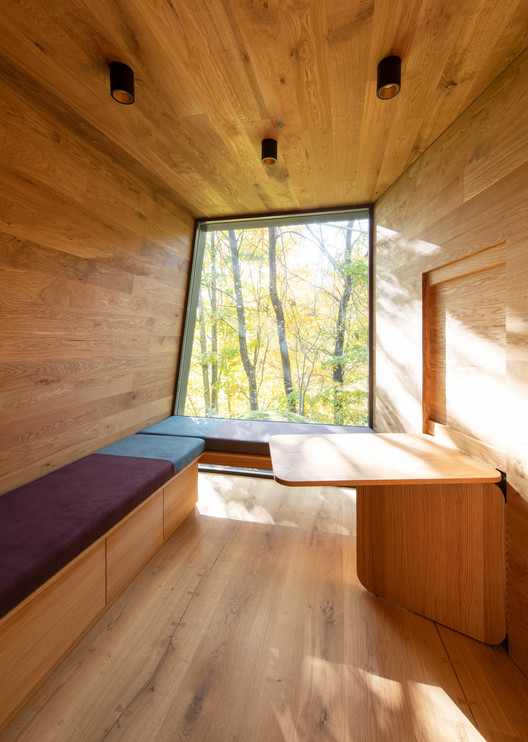Kunstmuseum Ahrenshoop Staab Architekten
2018-11-12 10:00
建筑师提供的文字说明。艺术家“阿赫伦肖特的殖民地位于菲施兰德与达罗斯之间的狭窄半岛上。波罗的海沿岸的人口稀少的地区,沙丘和广阔的草地和田地,提供了大量的景观。自从19世纪后期殖民地成立以来,它吸引了艺术家,他们的工作和家园反映了与景观和区域建筑传统的深刻联系。艺术博物馆是献给这些艺术家和他们的殖民地历史的。为此,在阿赫伦肖特入口处的土地的缠绕图与一个小型建筑预算一起提供。
Text description provided by the architects. The artists’ colony in Ahrenshoop is situated on the narrow peninsula between Fischland and Darss. This sparsely populated area on the Baltic Sea, with its dunes and expansive meadows and fields, offers a wealth of landscapes. Ever since the colony was founded in the late nineteenth century, it has attracted artists whose work and homes reflect a deep connection to the landscape and the region’s building tradition. An art museum was to be dedicated to these artists and the history of their colony. To this end a winding plot of land at the entrance to Ahrenshoop was made available along with a small construction budget.
Text description provided by the architects. The artists’ colony in Ahrenshoop is situated on the narrow peninsula between Fischland and Darss. This sparsely populated area on the Baltic Sea, with its dunes and expansive meadows and fields, offers a wealth of landscapes. Ever since the colony was founded in the late nineteenth century, it has attracted artists whose work and homes reflect a deep connection to the landscape and the region’s building tradition. An art museum was to be dedicated to these artists and the history of their colony. To this end a winding plot of land at the entrance to Ahrenshoop was made available along with a small construction budget.
我们的建筑理念的关键在于艺术家与景观的密切关系。其目的是创建一座建筑,乍一看,它似乎一直在那里,只有第二次看上去,它才能展现其作为一个文化机构的自主性。
The key to our architectural concept lay in the close relationship of the artists to the landscape. The goal was to create a building that at first glance seemed as if it had always been there, and only on second glance would unfold its autonomy as a cultural institution.
The key to our architectural concept lay in the close relationship of the artists to the landscape. The goal was to create a building that at first glance seemed as if it had always been there, and only on second glance would unfold its autonomy as a cultural institution.
首先要解决的问题是规模问题。博物馆比镇上的传统建筑大得多。只有发现所需的个别展览空间的大小与这些建筑物的大小相对应,才能找到一个设计解决方案。根据农田的概念,博物馆将由一组建筑组成,这些建筑物的大小是根据展览室的测量结果确定的。这种做法也使我们摆脱了困难情节的限制。围绕一个中心的个人“房屋”的组合将优先,而L形的财产轮廓将退到背景中。
The first problem to solve was one of scale. The museum was significantly larger than the town’s traditional buildings. Only the discovery that the size of the individual exhibition spaces desired corresponded approximately to the size of these buildings led the way to a design solution. Drawing on the notion of a farmstead, the museum would be composed of a group of buildings whose size was based on the measurements of an exhibition room. This approach also freed us from the constraints of the difficult plot. The grouping of the individual “houses” around a center would take precedence, while the L-shaped property outline would recede into the background.
The first problem to solve was one of scale. The museum was significantly larger than the town’s traditional buildings. Only the discovery that the size of the individual exhibition spaces desired corresponded approximately to the size of these buildings led the way to a design solution. Drawing on the notion of a farmstead, the museum would be composed of a group of buildings whose size was based on the measurements of an exhibition room. This approach also freed us from the constraints of the difficult plot. The grouping of the individual “houses” around a center would take precedence, while the L-shaped property outline would recede into the background.
这些建筑物对其同时代的起源毫不隐瞒。虽然它们是以当地建筑的形状为基础的,但它们的原型却归结为一种纯粹、抽象的形式。墙面和屋顶表面是无缝覆盖的正面材料,只有几个洞口。
The buildings make no secret of their contemporaryorigin. Although they are based on the shape of the local buildings, they distill their archetype down to a pure, abstract form. The wall and roof surfaces are seamlessly covered with a façade material penetrated only by a few openings.
The buildings make no secret of their contemporaryorigin. Although they are based on the shape of the local buildings, they distill their archetype down to a pure, abstract form. The wall and roof surfaces are seamlessly covered with a façade material penetrated only by a few openings.
外部和内部形式的对应导致了一种意想不到的空间体验。屋顶顶端的天窗加强了抽象的氛围。不间断的墙壁表面创造了一个集中的气氛,在其中小形式的展览充分发挥作用。
The correspondence of external and internal form leads to an unexpected spatial experience. A skylight at the apex of the roof enhances the abstract ambience. The uninterrupted wall surfaces create a focused atmosphere in which the small-format exhibits take full effect.
The correspondence of external and internal form leads to an unexpected spatial experience. A skylight at the apex of the roof enhances the abstract ambience. The uninterrupted wall surfaces create a focused atmosphere in which the small-format exhibits take full effect.
熟悉的形象和它不熟悉的翻译之间的紧张关系一直持续到外观的细节。垂直型黄铜外墙的结构唤起了人们对覆盖农舍屋顶的捆绑芦苇的记忆。甚至随着时间的推移,茅草屋顶变暗的现象也得到了回响,因为这些年来,黄铜幕墙从温暖的黄金变成了浅棕色。
The tension between familiar image and its unfamiliar translation was continued right down to the detailing of the façade. The structure of the vertically profiled brass façade evokes the memory of bundled reeds covering the farmhouse roofs. Even the phenomenon of the darkening of thatched roofs over time is echoed as the brass façade changes from warm gold to matte brown over the years.
The tension between familiar image and its unfamiliar translation was continued right down to the detailing of the façade. The structure of the vertically profiled brass façade evokes the memory of bundled reeds covering the farmhouse roofs. Even the phenomenon of the darkening of thatched roofs over time is echoed as the brass façade changes from warm gold to matte brown over the years.
这些关联是由建筑封套的自信、彻底的抽象所叠加的。新博物馆立足于当地建筑传统,探索新的设计路径,挑战我们的传统观念,将传统形象与其转变联系在一起。
These associations are superimposed by the confident, downright radical abstraction of the building envelope. Anchored in local building tradition yet exploring new design paths, the new museum challenges our usual perception and links the traditional image and its transformation.
These associations are superimposed by the confident, downright radical abstraction of the building envelope. Anchored in local building tradition yet exploring new design paths, the new museum challenges our usual perception and links the traditional image and its transformation.
Architects Staab Architekten
Location Weg zum Hohen Ufer 36, 18347 Ahrenshoop, Germany
Lead Architects Volker Staab, Per Pedersen, Anke Hafner
Photographs Stefan Mueller
Category Museums & Exhibit
 举报
举报
别默默的看了,快登录帮我评论一下吧!:)
注册
登录
更多评论
相关文章
-

描边风设计中,最容易犯的8种问题分析
2018年走过了四分之一,LOGO设计趋势也清晰了LOGO设计
-

描边风设计中,最容易犯的8种问题分析
2018年走过了四分之一,LOGO设计趋势也清晰了LOGO设计
-

描边风设计中,最容易犯的8种问题分析
2018年走过了四分之一,LOGO设计趋势也清晰了LOGO设计




























































